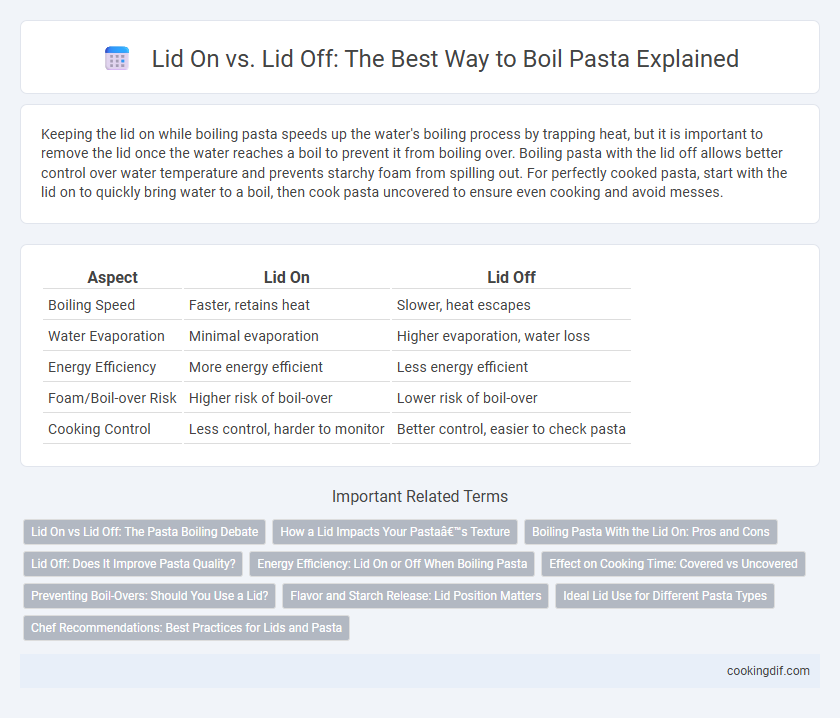Keeping the lid on while boiling pasta speeds up the water's boiling process by trapping heat, but it is important to remove the lid once the water reaches a boil to prevent it from boiling over. Boiling pasta with the lid off allows better control over water temperature and prevents starchy foam from spilling out. For perfectly cooked pasta, start with the lid on to quickly bring water to a boil, then cook pasta uncovered to ensure even cooking and avoid messes.
Table of Comparison
| Aspect | Lid On | Lid Off |
|---|---|---|
| Boiling Speed | Faster, retains heat | Slower, heat escapes |
| Water Evaporation | Minimal evaporation | Higher evaporation, water loss |
| Energy Efficiency | More energy efficient | Less energy efficient |
| Foam/Boil-over Risk | Higher risk of boil-over | Lower risk of boil-over |
| Cooking Control | Less control, harder to monitor | Better control, easier to check pasta |
Lid On vs Lid Off: The Pasta Boiling Debate
Boiling pasta with the lid on increases water temperature faster, reducing cooking time but risks foam overflow due to rapid boiling. Keeping the lid off allows better control over the water's boil and prevents starch foam from spilling, ensuring even cooking and maintaining pot safety. Most chefs prefer lid off to balance efficiency and quality, avoiding messy boil-overs during pasta preparation.
How a Lid Impacts Your Pasta’s Texture
Keeping the lid on while boiling pasta traps steam and heat, causing water to boil faster and maintain a consistent temperature, which can help achieve an evenly cooked, al dente texture. However, boiling pasta with the lid off allows excess starch to escape, preventing water from becoming too thick and ensuring pasta strands remain separate and less sticky. Managing lid position strategically during cooking optimizes pasta texture by balancing heat retention and starch dispersion.
Boiling Pasta With the Lid On: Pros and Cons
Boiling pasta with the lid on speeds up water boiling by trapping heat, reducing cooking time and energy consumption significantly. However, it increases the risk of water boiling over and resulting in a starchy foam mess on the stovetop. Cooking pasta with the lid off allows better control, preventing spills but requires more time and energy to reach and maintain a rolling boil.
Lid Off: Does It Improve Pasta Quality?
Boiling pasta with the lid off allows better control over the cooking process by preventing the water from boiling over and enabling constant stirring, which reduces sticking and promotes even cooking. This method helps maintain consistent temperature and avoids the risk of overcooking or sogginess, preserving the pasta's ideal al dente texture. Many chefs recommend keeping the lid off to achieve optimal pasta quality and texture.
Energy Efficiency: Lid On or Off When Boiling Pasta
Keeping the lid on while boiling pasta significantly improves energy efficiency by trapping heat and reducing boiling time, which lowers overall energy consumption. With the lid off, heat escapes, requiring more energy to maintain a rolling boil and prolonging cooking duration. Energy-saving benefits are maximized when heat is adjusted once boiling starts, preventing unnecessary fuel or electricity use.
Effect on Cooking Time: Covered vs Uncovered
Cooking pasta with the lid on traps heat and steam, significantly reducing boiling time by maintaining a consistently higher temperature. Leaving the lid off allows steam to escape, which can extend the cooking time but helps prevent water from boiling over. For quicker pasta preparation, covering the pot is more efficient, while cooking uncovered provides better control over water level and prevents spills.
Preventing Boil-Overs: Should You Use a Lid?
Boiling pasta with the lid on increases the risk of boil-overs due to trapped steam causing water to bubble rapidly. Leaving the lid off allows steam to escape, maintaining a controlled boil and preventing messy spills. For optimal pasta cooking, use a lid to bring water to a boil quickly, then remove it to avoid boil-overs.
Flavor and Starch Release: Lid Position Matters
Leaving the lid off while boiling pasta allows starch to be released gradually, enhancing the sauce's texture and flavor binding. Keeping the lid on traps steam and starch within the pot, which can cause water to foam and boil over, diluting flavor concentration. Managing lid position directly influences the pasta's starch release and ultimately the dish's sauce consistency and taste depth.
Ideal Lid Use for Different Pasta Types
Boiling pasta with the lid off is ideal for preventing water from boiling over and allows better control when cooking delicate shapes like orzo or small shells, which require gentle simmering. Keeping the lid on speeds up water boiling and is perfect for sturdier pasta varieties such as penne or rigatoni, where rapid boiling helps maintain firmness and reduces cooking time. Adjusting lid use based on pasta type optimizes texture and prevents overcooking or stickiness.
Chef Recommendations: Best Practices for Lids and Pasta
Chefs recommend boiling pasta with the lid off to prevent water from boiling over and to maintain consistent temperature control, ensuring even cooking. Keeping the lid off allows steam to escape, reducing the risk of starchy foam spilling and improving the texture of the pasta. For faster boiling, some professionals start with the lid on but remove it immediately once the water reaches a full boil.
Lid on vs lid off for boiling pasta Infographic

 cookingdif.com
cookingdif.com